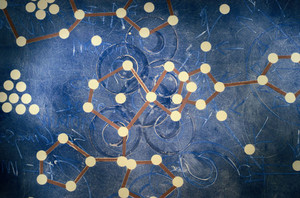Among the many features needed to prove sufficient biosimilarity to a licensed drug produced in living organisms, is coherency of the three-dimensional structure. The integrity thereof is vital for the efficacy and safety of a biopharmaceutical, and even small and local structural changes may result in loss of function or cause undesired side effects for the patients. Reliable assessment of the detailed three-dimensional structure, however, requires laborious analytical methods like Nuclear Magnetic Resonance (NMR) or X-ray crystallography. Another option, epitope characterization using antibodies specific for the target biologicals, is restricted by the availability of appropriate, well-characterized antibody panels and typically involves animal experiments.
Several studies have shown that it is possible to replace antibodies with so-called aptamers. Aptamers are short, single-stranded deoxyribonucleic acid (DNA) or ribonucleic acid (RNA) oligonucleotides, which can take on certain three-dimensional conformations that allow them to bind to a specific target. They are usually selected from vast oligonucleotide-libraries in an in vitro process termed SELEX (systematic evolution of ligands by exponential enrichment), wherein the oligonucleotides that bind most readily to the target are amplified and their nucleotide sequence is finally identified. In theory, aptamers can be generated for virtually any target molecule irrespective of size or immunogenicity, and they can distinguish between molecules that differ by as little as one methyl group. Aptamers could also successfully differentiate between native and heat-treated thrombin, whereas antibodies could not [1].
The objective of the study by Wildner et al. was to assess whether aptamers can be used to evaluate potential structural differences of the therapeutic IgG1 antibody rituximab [2]. This monoclonal anti-CD20 antibody represents a key therapeutic in the treatment of non-Hodgkin’s lymphoma. In combination with chemotherapy, rituximab has been shown to greatly improve outcomes for patients, but access to the therapeutic is impaired in countries with restricted financial resources due to limited insurance coverage. Affordable biosimilars could help alleviate this issue.
In total, six aptamers were found to reliably bind to rituximab within a robust experimental setup. One of the aptamers was found to also bind to the IgG1 monoclonal antibodies adalimumab and bevacizumab, as well as to the glycosylated Fc fragment of rituximab, suggesting that this aptamer binds to antibody constant regions. Furthermore, tests with thermally- and mechanically-stressed rituximab showed that four rituximab aptamers exhibited differences predominately in binding to samples stored at 40°C or exposed to UV light. As those stress conditions led to different recognition patterns, the involvement of distinct aptamer-rituximab binding epitopes can be anticipated. From a quality control point of view, our aptamers seem adequate as an orthogonal method to detect structural changes in rituximab during production and storage.
Using the panel of six aptamers, no significant differences between the originator biological MabThera (rituximab) and a proposed biosimilar candidate from the European market were detectable, supporting the high similarity of the biotherapeutic products. Interestingly, one aptamer coherently revealed divergent signals for all three batches of Reditux, the rituximab ‘similar biologic’ from the Indian market, in three independent experiments. Mass spectrometry-based analyses of these products revealed only minor differences between Reditux and the originator molecule MabThera, suggesting potential fold differences at the respective aptamer binding site.
In this study, the authors were able to show for the first time that aptamers are suitable for comparison of an originator biopharmaceutical and its biosimilar(s) when analysed in the native protein conformation. Aptamers are highly specific and demonstrate high reproducibility due to the fact that they are chemically synthesized. The authors thus suggest including the aptamer technology as an orthogonal analytical approach in the portfolio of analytical techniques for characterization of biologicals.
Conflict of interest
The authors of the research paper [2] reported that research funds of the Christian Doppler Laboratory for Innovative Tools for Biosimilar Characterization are partially financed by industry. For full details of the authors’ conflict of interest, see the research paper [2].
Abstracted by Gabriele Gadermaier, Michael Kohlberger, MSc, and Sabrina Wildner, PhD, Christian Doppler Laboratory for Innovative Tools for Biosimilar Characterization, University of Salzburg, Salzburg, Austria.
Editor’s comment
Readers interested to learn more about rituximab biosimilars are invited to visit www.gabi-journal.net to view the following manuscripts published in GaBI Journal:
Biosimilar rituximab in biological naïve rheumatoid arthritis patients
Phase I studies of infliximab and rituximab biosimilars demonstrate pharmacokinetic similarity
GaBI Journal is indexed in Embase, Scopus, Emerging Sources Citation Index and more.
Readers interested in contributing a research or perspective paper to GaBI Journal – an independent, peer reviewed academic journal – please send us your submission here.
Related articles
Biosimilars of rituximab
References
1. Zichel R, Chearwae W, Pandey GS, et al. Aptamers as a sensitive tool to detect subtle modifications in therapeutic proteins. PLoS One. 2012;7(2):e31948.
2. Wildner S, Huber S, Regl C, et al. Aptamers as quality control tool for production, storage and biosimilarity of the anti-CD20 biopharmaceutical rituximab. Sci Rep. 2019;9(1):1111.
Permission granted to reproduce for personal and non-commercial use only. All other reproduction, copy or reprinting of all or part of any ‘Content’ found on this website is strictly prohibited without the prior consent of the publisher. Contact the publisher to obtain permission before redistributing.
Copyright – Unless otherwise stated all contents of this website are © 2019 Pro Pharma Communications International. All Rights Reserved.








 0
0











Post your comment